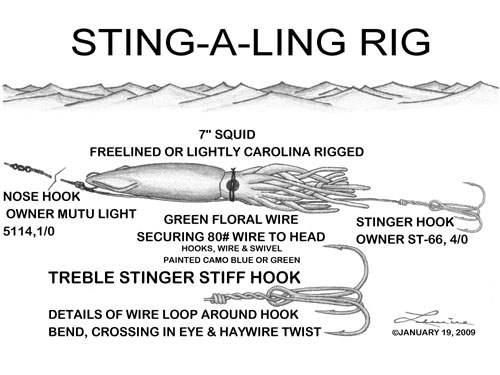
The Saltwater Magazine for Gulf Coast Fishing!
FISHING FORECASTS
| FISHING CALENDARS | ARTICLES | ADVERTISE
| SUBSCRIBE
Search Gulf Coast Fisherman's
Web Site
Past articles, specific
places or fish, etc.

The Sting-a-Ling
by Patrick Lemire
| CURRENT
MOON lunar phases |

Sting-a-Ling?" You bet. This rig has a surprise for a short striker or mouther - a camouflaged, extended and suspended stealth wire and treble hook behind a whole 6-8" squid. How many times have you had a sizeable ling approach your bait and mouth it or turn away at the last moment without a hookup? The Sting-a-Ling rig greatly slants the odds in your favor by giving them something not to look at. The camo blue or green wire and treble hook virtually disappears, making the squid and its tentacles in motion the only target for your ling to see.
Making this rig isn't complicated; reading about it and looking closely at the illustration takes longer than twisting up the wires to the swivel and hooks. The components needed to make up one of these sting-a-ling rigs consist of the following: A freshly thawed squid of 7", a 130 lb. swivel, 34" of no. 7, 80 lb. hard wire, a light wire circle hook, size 1/0, a 4/0, 4X- strong treble stinger hook and 5" of green floral wire.
- Counting 3" lost at each of the four haywire twists, you will end up with a body hooked 7" squid, with a treble trailer about 3" beyond its outstretched tentacles and around 11" of wire leader and swivel ahead of it. Start by cutting two 17" pieces of wire. Haywire twist a 17" wire to the swivel; the other end is then haywire twisted to the 1/0 circle hook.
- Next, bend the other 17" wire 180 degrees, 4" from one end;
cross both ends through the treble hook's eye and pass the wire's 180 degree
bend around one of the hook's bend, carefully pull snug against the bend.
Now, form the haywire twist outside the eye. You now have a stiff hook
wire wrap.
- Lastly, bend the other end at 3" and then form the last haywire twist at the circle hook's eye, watching out for the treble hook. After the camo spray painting all the wire, etc. either blue or green, the wire is ready for use. See the illustration for the final "look" of a rigged 7" squid.
- The stiff hook wire wrap that's isolated on the illustration greatly adds to the stiffness of the connection, keeping the treble aligned for better hooksets. Camo spray paints I use, all by Rust-O-Leum, are Royal Blue no. 7727, John Deere Green no. 7435 and Clear Matte no. 79028330. Lightly spray the color; when dry, apply the clear matte to kill the shine.
- When ready to fish this rig, attach the squid to the nose hook (a small circle that's virtually impossible to have a ling hookup) Use floral wire to hold the wire against the squid body and snugly wrap it around the head/eye area; secure with a few twists together of the ends. This step is important in that it keeps the wire and treble in alignment with the squid's body.
- When sight casting to a near surface swimming ling, always wear a dark underbilled cap to help keep the direct sunlight out of your eyes and polarized sunglasses to cut the water's surface glare. You can't sight fish'em if you can't see'em. Using Spectra of 80-100 lbs. for the main line off the reel gives a much better feel for what's going on at the hook and definitely gives fast, solid hooksets.
- This is definitely a big ling rig, say from 50 to 80 lbs. plus that might be more wary than a much smaller one.
- When casting, slow it down just before the rig hits the water. This straightens it out away from you and ready to look like something to eat by your target. Casts to a distant swimmer need to be made to where your squid is either crossing their swim path or crossing and going away on the retrieve.
- Whether you have cast out or just have your squid slowly drifting back in the current, you must set the hook at the first tick of tension on the line. This also applies when you see the ling in position to have the "unseen" camo stinger treble around or in its mouth Hang on after the hook set!
- A quick recap of the "ling fast to the gaff procedure" I've outlined before goes like this: After the hookup, apply side pressure horizontally with your rod. If the ling is off to your left, apply right side pressure - as it crosses in front of you, quickly reverse the side pressure to the left. This is done even if the ling is deep enough not to be seen, most times they will come to the near surface area rather quickly. During this zig-zagging swim, you should be gaining line with short rod strokes, applying the pressure and reeling the ling toward the boat. I use 15 to 18 lbs. of drag pressure to assure this movement of the ling to the boat.
- A ling of 50-80 lbs. can be brought to the boat in around one minute. Coming to the boat "green", presents a safety situation. If in your own boat, be prepared to swing the ling aboard on the gaff or gaffs and directly into a fish box. If on a charter or partyboat, get out of the way. A ling thrashing around on the deck with its powerful tail and body motions can do you, your tackle, and coolers a lot of damage! Think about this before bringing any ling aboard.

